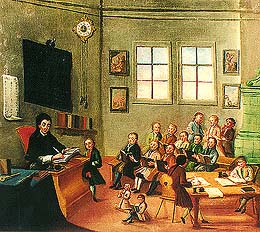History of Education in the Český Krumlov Region
 The beginning of
education in the region of Český Krumlov was closely linked with
the Church institutions, as the oldest schools were established
alongside parish churches or monasteries, for example the Vyšší
Brod Monastery or the Zlatá
Koruna Monastery. Peter I. von Rosenberg obtained his education
from the Vyšší Brod monastery.
The beginning of
education in the region of Český Krumlov was closely linked with
the Church institutions, as the oldest schools were established
alongside parish churches or monasteries, for example the Vyšší
Brod Monastery or the Zlatá
Koruna Monastery. Peter I. von Rosenberg obtained his education
from the Vyšší Brod monastery.
In Český Krumlov the beginning of education fell into the second half of the 14th century, when the pronounced centre of culture and education became the parish St. Vitus Church in Český Krumlov.
In the second half of the 15th century and at the beginning of the 16th century the Latin School of Český Krumlov experienced a period of expansion, during the time the education was carried out by priests.
Further expansion of the education system happened during the reign of Wilhelm von Rosenberg, who called the Jesuit order into the town. In 1584 a Jesuit Václav Šturm began teaching in Český Krumlov, he later became the first rector of the Jesuit college. Wilhelm von Rosenberg already talked about the founding of this college in the year 1585, a year later the foundation stone of the building was laid down - today Horní No. 154. In the middle of the 17th century the whole area of the Jesuit order in Český Krumlov expanded by another new building, the Jesuit theatre (Horní No. 153), which continued with the tradition of an older wooden Jesuit theatre, and especially by a new building of the Jesuit seminary in the Early Baroque style from the 1650 - 1652 (Horní No. 152). The best known school master, who taught here was a Bohemia intellectual, a man of letters and historian Bohuslav Balbín.
The Terezian school reform from 1774 organised, besides elementary schools, in each region also a main school. It was established in 1779 also in Český Krumlov, and used the building which was once the Jesuit seminary (Horní No. 152). Apart from elementary teaching (reading, writing and arithmetic) the pupils learned the basis of Latin, geography, biology, composition, drawing and geometry, and also the basis of economy.
Two totally individual educational establishments were connected with the introduction of compulsory education of the Austrian Empire - a model industrial school in Kaplice (School in Kaplice), which was established by Ferdinand Kindermann, and the general School in Zlatá Koruna, which was established by the abbot of the Zlatá Koruna Monastery Bohumír Bylanský . Apart from the basic subjects like reading, writing, arithmetic the children were also taught geography, history and natural history. A large emphasis was placed on obtaining practical experience in sectors of - cultivation of plants, breading of animals, trade craft or household duties. Following the didactic principles of Jan Amos Komenský, a great emphasis was placed on teaching by using equipment aids like maps, educational pictures and collections of natural products (artefacts). A similar curriculum was also provided by the School in Kájov, its development is continually supported during the 17th and 18th centuries.
 Secondary education was
developed by Joseph zu Schwarzenberg at the beginning of the 19th
century, he set up a Forestry School in Zlatá Koruna and the
remarkable Schwarzenberg
Economic Institute in Český Krumlov in the year 1801. This
school enabled a specialised education for future Schwarzenberg
employees.
Secondary education was
developed by Joseph zu Schwarzenberg at the beginning of the 19th
century, he set up a Forestry School in Zlatá Koruna and the
remarkable Schwarzenberg
Economic Institute in Český Krumlov in the year 1801. This
school enabled a specialised education for future Schwarzenberg
employees.
On November 1, 1871 the first class of a private grammar school was opened in Český Krumlov with German as a teaching language. After several repeated requests, which were supported by the duke of Schwarzenberg, the school was taken over by the state. Room were made available in the original building of the Jesuit institute.
In the year 1896, when the grammar school was celebrating its
jubilee, the school had 271 pupils. The building in Horni No. 152,
was used by the grammar school until 1939/40. A well known
personality of the German grammar school was professor Johann Josef
Ammann, who took an interest in the local folklore and in 1892
published an adapted text of the Passion Plays of Hořice. We can
mention one of the graduates of the grammar school, a professor of
the Vienna University, Gustav
Jungbauer.
(mj)
Further information:
History
of Schools in Český Krumlov
Elementary
school in Vyšší Brod

